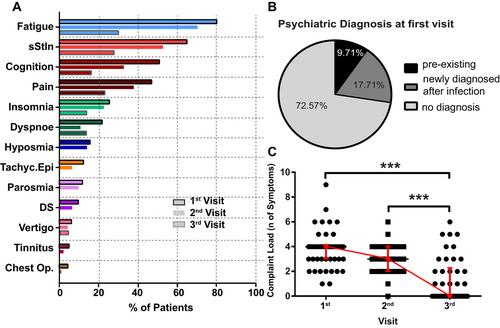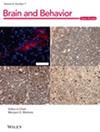High Somatization Rates, Frequent Spontaneous Recovery, and a Lack of Organic Biomarkers in Post-Covid-19 Condition
Abstract
Introduction
Many patients report neuropsychiatric symptoms after SARS-CoV-2 infection. Data on prevalence of post-COVID-19 condition (PCC) vary due to the lack of specific diagnostic criteria, the report of unspecific symptoms, and reliable biomarkers.
Methods
PCC patients seen in a neurological outpatient department were followed for up to 18 months. Neurological examination, SARS-CoV-2 antibodies, Epstein–Barr virus antibodies, and cortisol levels as possible biomarkers, questionnaires to evaluate neuropsychiatric symptoms and somatization (Patient Health Questionnaires D [PHQ-D]), cognition deficits (Montreal Cognitive Assessment [MoCA]), sleep disorders (ISS, Epworth Sleepiness Scale [ESS]), and fatigue (FSS) were included.
Results
A total of 175 consecutive patients (78% females, median age 42 years) were seen between May 2021 and February 2023. Fatigue, subjective stress intolerance, and subjective cognitive deficits were the most common symptoms. Specific scores were positive for fatigue, insomnia, and sleepiness and were present in 95%, 62.1%, and 44.0%, respectively. Cognitive deficits were found in 2.3%. Signs of somatization were identified in 61%, who also had an average of two symptoms more than patients without somatization. Overall, 28% had a psychiatric disorder, including depression and anxiety. At the second visit (n = 92), fatigue (67.3%) and insomnia (45.5%) had decreased. At visit three (n = 43), symptom load had decreased in 76.8%; overall, 51.2% of patients were symptom-free. Biomarker testing did not confirm an anti-EBV response. SARS-CoV-2-specific immune reactions increased over time, and cortisol levels were within the physiological range.
Conclusion
Despite high initial symptom load, 76.8% improved over time. The prevalence of somatization and psychiatric disorders was high. Our data do not confirm the role of previously suggested biomarkers in PCC patients.


 求助内容:
求助内容: 应助结果提醒方式:
应助结果提醒方式:


